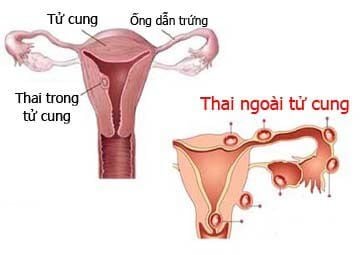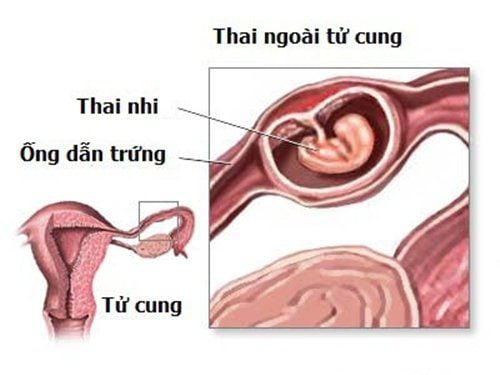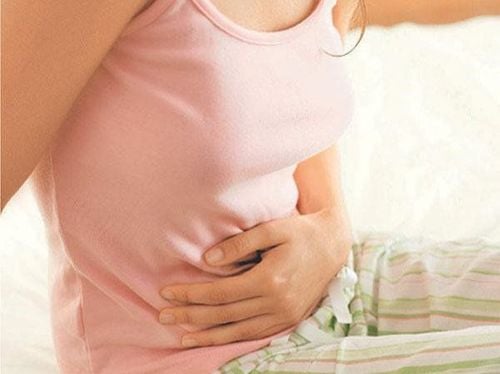This is an automatically translated article.
The article was consulted with Specialist Doctor II - Nguyen Thi Minh Tuyet - Head of Obstetrics and Gynecology Department - Vinmec Central Park International General Hospital.An ectopic pregnancy is an abnormal and unwanted pregnancy in families. This phenomenon, if not detected and treated promptly, can seriously affect the health of pregnant women.
1. What is an ectopic pregnancy and how does it happen?
Normal conception occurs in the outer third of the fallopian tube. The ovum, after combining with the sperm, is called a fertilized egg, and gradually develops into an embryo. After being fertilized, the egg will gradually move to the uterus to implant and develop into a fetus in the uterus.Ectopic pregnancy occurs when the movement of the fertilized egg is delayed or there is no movement, when the fertilized egg continues to develop gradually into an embryo and placenta in the gestational sac outside the uterus. bow. Locations of ectopic pregnancy include:
More than 95% of ectopic pregnancies occur in the fallopian tubes: tubal, ambulatory, isthmus or interstitial. Only about 5% occur in other locations such as: In the abdomen, ovaries, cervix or old surgical scars.

2. Who is prone to ectopic pregnancy?
The following women have a higher than normal risk of having an ectopic pregnancy:Women who have pelvic inflammatory disease, caused by Neisseria gonorrhoeae and Chlamydia trachomatis, which cause tubal adhesions oviduct. People with a history of ectopic pregnancy. People who have had an abortion will increase the risk of ectopic pregnancy by 5 times compared with the general population. In addition, there are other risk factors such as:
Intrauterine device. History of infertility. Smoke. Having sex with multiple people. Early sex: This is an indirect factor in causing sexually transmitted diseases.
3. Some questions related to ectopic pregnancy
3.1. Does an ectopic pregnancy require removal of the ovaries? Because the most common location of ectopic pregnancy is in the fallopian tube, most of the ovaries are kept intact after an ectopic pregnancy.Cases of ectopic pregnancy located in the ovary leading to ovarian intervention are very rare.
3.2. Can I be infertile after ectopic pregnancy?

First, consider the case of laparoscopic surgery, preserving the fallopian tubes. After 3 months of surgery, the patient underwent a hysteroscopy - a contrast-enhanced fallopian tube was injected into the uterine cavity through the vagina to evaluate abnormalities in the uterus and fallopian tubes. This technique is performed on the 8th - 10th day of the menstrual cycle, counting from the first day of menstruation.
According to the statistics, the results show that the rate of tubal catheterization when the drug is instilled is 78%. This allows the patient to have a normal pregnancy in the future. This is a step forward to help women unfortunately have an ectopic pregnancy still want to be mothers.
In the case of open caesarean section, will removing the side of the fallopian tube containing the gestational sac cause infertility? For women who have had an ectopic pregnancy once, meaning that one side of the fallopian tube is still normal, it is still possible to have a normal pregnancy, although the pregnancy rate has been reduced by 50% compared to normal women. .
In the case of waiting more than 1 year and still not pregnant, the patient needs to go to the doctor to check if the remaining fallopian tube is open or not. If that fallopian tube is blocked, a laparoscopic approach can be performed. This method is more effective than artificial insemination.
In the case of a bilateral ectopic pregnancy, both fallopian tubes must be removed, and normal fertilization will not be possible. At this time, you need to carry out in vitro fertilization if you still want to get pregnant and become a mother.
Thanks to the development of imaging technology, it helps to detect ectopic pregnancy early, helps to preserve good fallopian tubes, thereby maintaining normal fertility for the patient. Women who have to remove both fallopian tubes can still get pregnant by IVF. If you have unusual symptoms, you should be examined and consulted with a specialist.
Please dial HOTLINE for more information or register for an appointment HERE. Download MyVinmec app to make appointments faster and to manage your bookings easily.














